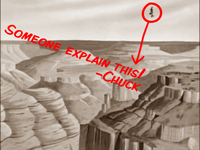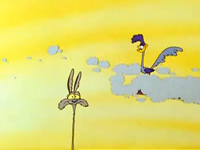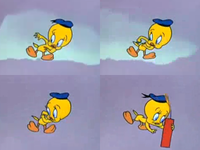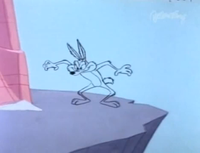Cartoon physics
Cartoon physics, also known as cartoon mechanics, is a theory of mechanics in modern physics that seeks to explain behaviour left unexplained by Newtonian mechanics or even by general relativity. Described first in the seminal work Looney Tunes, the theory has gained massive media recognition as a refreshing alternative to other ideas such as string theory or even quantum mechanics. However, detractors claim that the ideas outlined in cartoon physics are too cartoonish.
The theory includes various aspects of other mechanical theories, such as extra dimensions, non-instantaneous action at a distance, and even quantum superpositions (although at a macroscopic scale, thereby missing the entire point of quantum superpositions). However, the manner in which such concepts are formulated within cartoon physics are radically different, which is to say that the concepts are replaced with stuff made up off the top of one's head. Their implications have revolutionised worlds, often making seemingly outlandish phenomena not only possible, but also torturously frequent.
History[edit]
Cartoon physics was developed and presented independently and almost simultaneously by three well-staffed, well-funded laboratories. These were: the research division of Warner Bros. in Burbank, California; Walt Disney's experimental physics centre, also in Burbank; and Metro-Goldwyn-Mayer's laboratories in Los Angeles, California.
The theory was born soon after these laboratories started developing "animated shorts", thought experiments which were subsequently presented to fellow theorists and the public via the medium of film. These shorts were expected to follow Newtonian mechanics or, should one make certain assumptions about scale, general relativity. However, the results of such shorts completely reversed conventional expectations. One of Walt Disney's first shorts, for example, included an automobile completely unaffected by gravity for three full seconds. Theorists, absolutely flabbergasted, went to work on a theory that would explain such behaviour.
One pair of prominent theorists was Hugh Harman and Rudolf Ising. Remarkably talented "animators"—as was the proper title for theorists specialising in their particular sort of thought experiment—Harman and Ising worked initially at Disney's physics centre. Eventually they moved to Warner Bros, where they continued their series of experiments, "Looney Tunes". Other subjects, such as Bugs Bunny and Wile E. Coyote, were later created by other theorists such as Chuck Jones and Friz Freleng, to demonstrate the universality of basic implications of the laws of cartoon physics. Another pair of groundbreaking theorists: William Hanna and Joseph Barbera continued the pursuit of a complete theory of cartoon mechanics in their cat-and-mouse thought experiments, and made significant progress. However, since the 1950s, it would appear that most of the principles of cartoon physics with regards to mechanics have now been completely described.
Principles and implications[edit]
Gravitational action at a distance[edit]
Cartoon physics, like other modern theories of physics such as general relativity, rejects Newton's idea of instantaneous action at a distance with regards to gravity. However, the implications of the formulation of non-instantaneous gravitational action in cartoon physics are unusual to say the least.
Usually, gravity behaves according to general relativity, and on the everyday scale it appears as though gravity acts upon an object instantly as Newtonian mechanics would demand. However, on very rare occasions, the rate at which gravity acts becomes incredibly slow. This phenomenon is called delayed gravitational action, or DGA. DGA affects cross-sections of the body affected at a discernibly distorted rate, causing cross-sections of the body to fall at continuously varying rates.
This effect of DGA usually results in the precise opposite of Lorentz contraction, in which the object affected will stretch downwards before starting to observably drop. The point from which the affected body stretches is irrelevant to the overall centre of mass. Often the degree of effect gravity has is dependent on the cross-section of the volume that is affected, meaning that, for a large animal or human experiencing delayed gravitational action, necks are likely to be stretched the furtherest.
DGA theoretically has significant implications. For instance, it vindicates Aristotle's experiment of the rock and the feather, although for the wrong reason: the rock falls faster not because of its greater weight, but because of its greater volume. In addition, it means that if a villain suddenly finds himself in a gravitationally disadvantageous situation, he has enough time for a final speech or last glare into the fourth wall before falling whole to his death.
Extra dimensions[edit]
Large extra dimensions and warped extra dimensions have both been theorised in string theory, and string theorists have attempted to implement those features in later theories, which currently have only compact extra dimensions. However, cartoon physics was a theory that not only incorporated, but also predicted the existence of large, warped extra dimensions (LWEDs), the name coming from the warped nature of the dimensions and not from the warped nature of the cartoons.
The presence of such LWEDs enable unusual phenomena. According to certain varieties of cartoon physics, dimensionally transcendental spaces are constantly generated behind bodies in motion, and decay once the body's velocity drops to zero. This allows storage of a massive inventory of items such as hammers, guns, etc. However, this inventory is likely to disappear if the moving body stays in rest for too long; many animated characters have lost their fifth fingers for this very reason.
The most popular formulation of cartoon physics with LWEDs is a theory proposed by Hugh Harman called H-theory. What the H stands for is a subject of much mystery. Some believe it stands for "Hammerspace" or "Hyperspace", popular nicknames for the dimensionally transcendental spaces caused by LWEDs. Others believe "H-theory" stands for "Higher theory" in the sense that it ties together all other formulations of cartoon mechanics together. Still others ascribe to the vanity camp, claiming that the H stands for both "Hugh" and "Harman"; others claim note that the letter H is the same as the first letter of "Harman"—i.e. H—turned upside down. A small minority, however, puts forward a radical theory about the exact meaning of the word H-theory, which is that it really should not matter much and everybody should start caring more about the actual workings of the theory.[1]
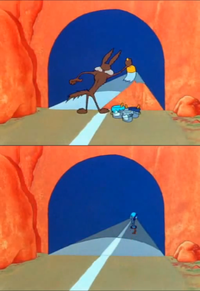
Quantum locking[edit]
The concept of quantum locking is the concept of cartoon physics that has the shallowest roots in established physics concepts. While it is somewhat related to quantum superpositions, wavefunction collapses associated with observation, and other fuzzy aspects of quantum mechanics, mostly the general idea of quantum locking is far closer to some concept that would appear in a Doctor Who episode.[2]
The main idea of quantum locking lies in ambiguity of the nature of an entity when it is not being observed. Here is an example from the Richard Feynman of cartoon physics, Bugs Bunny (not just because both of them have a New York accent):
| “ | So, say Wile E. Coyote paints a trompe d'œil, right? A painting of a tunnel, good enough to fool dat Road Runner. He looks at it, it's a solid paintin'. But then, all of a sudden, he turns away, and the whole thing gets kinda murky, huh? And then it's not dat obvious dat Road Runner would crash into the paintin' so much as walk right through it, huh? By the time dat coyote turns back towards the paintin', Road Runner's gone. Now the coyote's observin' it again, and that quantum lock turns back on, ya see? So dat coyote tries runnin' into the paintin', except it won't work for him. Because now it's obvious dat it's a paintin', ya see? | ” |
In summary, Wile E. Coyote's observance of his painting causes the wavefunction to collapse and fix the painting in its normal state. However, once he stops observing it, the wavefunction reverses its collapse, and there is a possibility that the painting is no longer just a painting, but an actual tunnel that Road Runner conceivably could—and does—walk through. Once Wile E. Coyote returns to observing the painting of the tunnel, it becomes definitive that the painting is just a painting, and the wavefunction collapses, leaving the most probable state, which happens to be a solid, pain-inflicting one. Of course, Road Runner's observance of the painting does not count because his brainpower is dedicated to peripheral vision, running, and making that weird meep meep sound, and so does not exactly count towards observation. The audience's observance of the painting also does not count because they are idiots.
Quantum locking is not limited to physical entities. The concept is easily extended to force fields, such as gravity. Physical bodies tend not to fall at any rate unless the body actively observes the force of gravity by becoming conscious of what effect it should have, at which point gravity is quantum locked and begins to take effect. It should be noted that quantum locking of gravity and the abnormal phenomenon of delayed gravitational action are not mutually exclusive; the latter typically takes over after gravity becomes quantum locked. In fact, experiments consistently show a correlation between quantum locking of gravity and DGA.
Optical implications[edit]
Cartoon physics also has its effects on optical phenomena. Recently, the theory has extended beyond being a theory of just mechanics, and theorists have only just begun to look into the fundamental principles of cartoon physics about electromagnetism, and especially their implications on electromagnetic radiation.
Paradoxically, ultimate implications of such principles are already well-known. Cartoon physics is believed to describe negative index metamaterials at some level or other. The negative refraction indices of such materials enable objects to be absolutely invisible, because it coaxes the individual photons approaching the material to suddenly begin chasing each other around and execute several dozen slapstick routines. The invisibility that results is often used by various characters for chasing each other around and executing several dozen slapstick routines. The knowledge of the manufacture of such materials, however, is still beyond human knowledge, and has been attained only by far more intelligent lifeforms, such as bunnies and coyotes.
Questions on validity[edit]
The most prominent criticism of cartoon physics is its supposed lack of testability. The controversy centres around two properties of the theory:
- Its entire formulation is based on thought experiments that may not yield entirely valid ideas.
- There is no way to confirm with certainty that cartoon physics applies to any universe.
Should these claims be true, then cartoon physics is an absolutely useless theory that may not even describe anything whatsoever in real life. Unfortunately, questions on testability appear to raise a highly valid point. Cartoon physics is based on some prior theories of physics, which means it is falsifiable to some degree; however, there does not appear to be any real-life experiment that would yield actual results specific to cartoon physics. In conclusion, most critics say,
| “ | it's complete nonsense. | ” |
Nevertheless, supporters have fired back, saying that they will have an observable prediction "any minute now". In addition, they have noted that the principles of cartoon physics will always have a place in TV Tropes.
See also[edit]
- Looney Tunes
- Wile E. Coyote
- String theory
- General relativity
- Quantum mechanics
- Isaac Newton
- Albert Einstein

